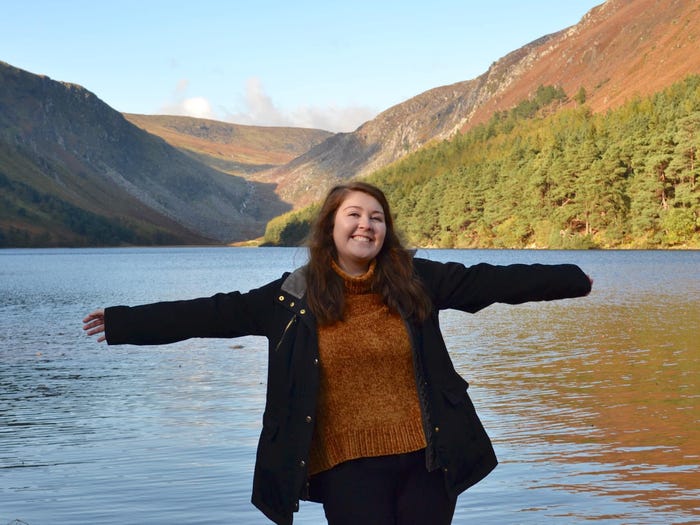I moved from the US to Ireland. Here are 11 things I wish I knew before relocating.
8 min readI moved from the US to Ireland. Here are 11 things I wish I knew before relocating.

Alexis McSparren
- I moved from the US to Ireland through the Irish Working Holiday Visa four years ago.
- Finding things like a full-time job, affordable housing, and a good group of friends was difficult.
- The country can be expensive, but I’ve learned there’s so much to explore, especially by car.
In 2019, I moved from the US to Ireland and didn’t look back.
All I had were two very large suitcases, about $4,000 in savings, and a folder of crinkled paperwork for my Irish Working Holiday Visa, which allows recent graduates to travel and work in Ireland for a year.
I set off with no job or housing lined up, no relatives or connections to the country, and basically no plans in general, and I’ve gotten so many questions from people around the world wanting to know how I did it.
Years later, I wish I could’ve offered my 23-year-old self some words of wisdom.
Save as much as you can because Ireland can be expensive
Alexis McSparren
Ireland is a very expensive place to live, and my savings disappeared more quickly than I budgeted for.
I saved as much as possible before I arrived because I knew it would give me a better security cushion in case it took me longer than expected to find a job.
I skipped out on nights out and meals with friends for nearly a whole year before moving. When it came down to it, I reasoned that I’d rather have a pint of Guinness in Dublin than another latte from a Starbucks in Missouri.
Finding a job in Ireland is tough, especially if you’re not in the country yet
Alexis McSparren
For months before moving, I received the same response from countless job applications: “Let’s talk when you’re on the ground.”
I’ve learned that you’ll only start receiving serious responses once you’re physically located in Ireland (with your Irish address and phone number listed on your resume to prove it).
Sadly, the Irish job market is extremely competitive, especially in Dublin. I applied to hundreds of jobs for months and didn’t hear back from most of them. I even started nannying just to get some Ireland-based experience on my CV.
Although there are plenty of casual and short-term jobs, you’ll be competing with other Irish high-school and college students as well as young people from the European Union.
Those groups typically fill up spots first, especially for temp roles or tourism and hospitality jobs.
But you can still further your career as an American in Ireland
Before moving to Ireland, my only professional experience was as a marketing coordinator at a nonprofit. Fresh out of college, I didn’t have much on my resume, and I assumed that the only places I’d find work were coffee shops or retail stores.
After several months of no luck followed up by a few temporary admin roles, I was finally able to break into my desired field by networking through several recruitment agencies.
Unlike what I experienced in the US, this was the easiest way to get a full-time job in Dublin. It opened the door for me to gain permanent contract roles in my chosen field.
On the Working Holiday Visa, sponsorship is also an option for those looking to stay permanently in Ireland. If your employer decides to sponsor you, it could lead to a work visa, which would ultimately earn you permanent residency — as long as you stick to the job for two to four years.
Finding housing in Ireland is equally as difficult, if not harder, than job hunting
Alexis McSparren
Finding housing in Ireland overall is very difficult, but finding housing in Dublin is a struggle. And unfortunately, it’s getting harder every year.
Don’t be alarmed if you go to a packed viewing for a single bedroom for rent in a shared house. And don’t be surprised when that bedroom comes with a whopper of a price tag.
In Dublin, you can easily spend €2,000 (about $2,100) on rent each month, and even in smaller towns, it’s typically €1,500 (about $1,575) a month.
Setting up an Irish phone number is a must
For my first few months, I made the mistake of keeping my American phone number, which seemed to hurt my chances while applying for housing, jobs, and basically anything I needed in Ireland.
I found that people seem to trust you more as soon as they see you have an Irish number. It shows a commitment to living here and putting down roots, so I recommend making the switch as soon as possible.
To make life easier, you can pay to have your phone “unlocked” (if it isn’t already) and buy an Irish SIM card with a noncontractual phone plan.
Even if you’re just traveling around Europe and you don’t want to pay the over-the-top fees for international data and calls during your vacation, just buy a cheap SIM card wherever you’re staying. They usually last about 28 days.
This gives you the freedom of unlimited data, so you can use social media or Google Maps wherever you go.
Americans living abroad can still vote in US elections — and the process isn’t too difficult
When moving abroad, it’s important to research how voting from overseas works in your country.
Unfortunately, in Ireland, voting can only happen onshore — so Irish citizens have to make a special trip back home. But for US citizens, votes still count while living abroad.
I’ve voted absentee online for the last two US presidential elections, and it was very easy once I looked up the process.
It’s not always rainy (but it usually is)
Alexis McSparren
There’s a good reason why the Irish love to talk about the weather so much. The country is well-known for being windy, dreary, and rainy almost year-round, so be sure to pack accordingly.
But every year when March rolls around, there’s a collective sigh of relief — everyone is excited for the months of dark and wet days to finally be over.
From March to September, one can expect sporadic glorious weather in Ireland.
Alexis McSparren
Although the summers are much milder, it’s commonly overcast and rain can start pouring at any time out of a perfectly blue sky.
Because the weather is so unpredictable, it’s prompted the age-old Irish saying, “You can see every season in a day.”
Less is more when it comes to packing
When I first traveled to Ireland, I had two large suitcases filled to the brim. But one would’ve been plenty if not more than enough.
Even though it’s an expensive country, Ireland has some great cheap shops to pick up whatever you may need at home — so only pack what you’re prepared to lift up multiple flights of stairs and roll down narrow cobblestone streets.
Penneys (also known as Primark outside of Ireland) is a true Irish staple. You can buy clothes, shoes, homeware, and pretty much everything else under the sun. The best part is it’s cheap without really skimping on quality.
Explore as much as you can, especially by car, if possible
Alexis McSparren
From UNESCO World Heritage sites to world-class beaches to quirky villages with even quirkier traditions, Ireland is a fascinating country to explore.
It’s pretty small (about the size of the state of Indiana), but its counties all vary greatly from each other, with different bits of ancient history to explore in each.
Alexis McSparren
I don’t currently have a car (one day I’ll force myself to learn to drive on the opposite side of the road), so I rely on public transport to get around, which is more convenient and cheaper than driving in the city.
But there’s a whole country to explore outside of Dublin, and because Ireland is so rural — with many winding and narrow country roads that Google Maps doesn’t even recognize — driving is the best way to explore.
Thankfully, my Irish partner has a car, and we’ve been able to take scenic road trips.
Finding my people in Ireland took some time
Alexis McSparren
I went into my move to Ireland wearing rose-tinted glasses when it came to finding friends.
It can take a while to break into friend groups, especially when they’ve been together since school. But I’d recommend befriending both international and Irish people as there’s such a mix in the country.
I’ve become really close with most of my coworkers, and I’ve also made several friends through other friends.
I found that joining social-media pages or Facebook groups dedicated to Americans or expats in Ireland has really helped me to meet people. It’s so nice to be able to chat with a fellow American and vent about the things we miss about home.
You can’t plan for everything, but you can still have the craic
I’ve discovered the hard way that there’s not much you can prepare in advance for outside of temporary accommodations when moving to Ireland on a Working Holiday Visa.
It’s nearly impossible to have a job or long-term housing set up beforehand. And as a type-A person who loves to make lists and meticulously plan everything in advance, that was kind of terrifying.
But Ireland is a land full of adventure, welcoming people, and plenty of craic (fun).
Now, each year when I return home to the US for the holidays, I find myself far more sure of myself and my abilities.
My most pressing advice for people wanting to make the move is just to do it. We can’t grow if we never do things that terrify us.
This story was originally published on February 6, 2022, and most recently updated on May 8, 2023.



